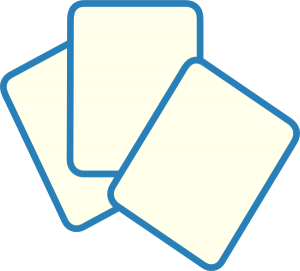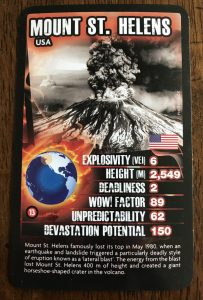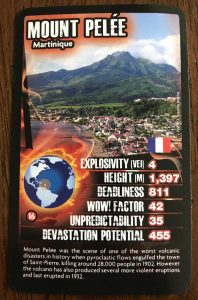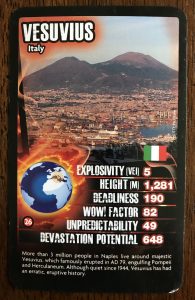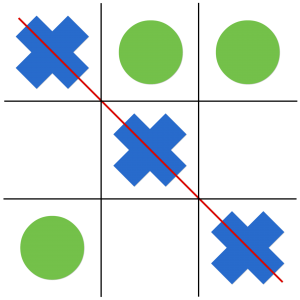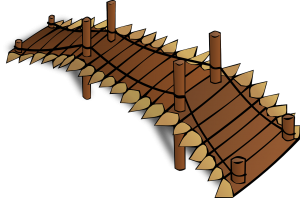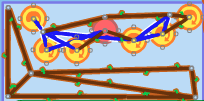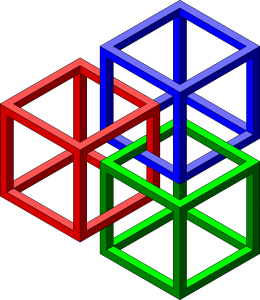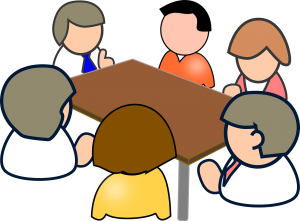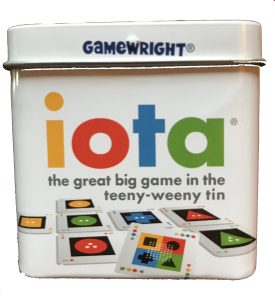
One of my favourite games is Iota. I bought it for my daughter to take to camp a few years ago. She never played it at camp and I don’t think that anyone opened it until last summer. I was going to a cottage for the weekend and I grabbed it on a whim. At the cottage someone else opened it to play, and I have been hooked ever since.
The premise of the game is to lay out cards, almost in a Scrabble like fashion. Each card has a number from 1 to 4, a colour of either red, green, blue, or yellow, and a shape of either a plus sign, square, triangle, or circle. Each player gets four cards at the beginning, and just like in Scrabble, replenishes the cards based on the number used during the turn.
Let’s say this is Player 1’s hand:
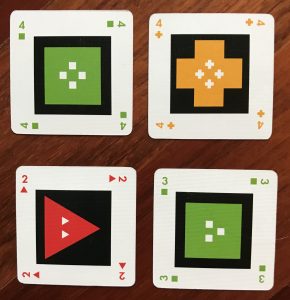
A possible move would be to lay out the following cards:
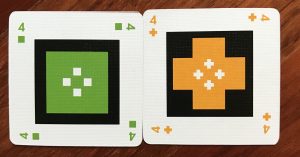
This turn would be worth 8 points for player 1, the value of the numbers on the cards. Player 2 has the following hand:
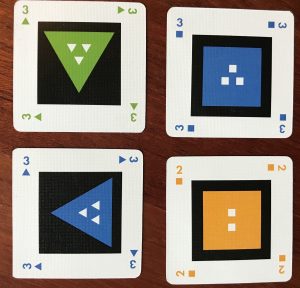
Player 2 now has to decide what cards to add to the board. Cards can be added in such a way to make sets of 4 where all cards either share all properties with each other, share some properties with each other, or share no properties with each other. Player 2 decides to add the green 3 triangle and the blue 3 square like this:
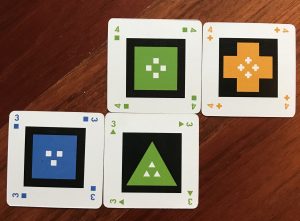
Player 2 has earned 13 points for this move. Just like in Scrabble, all connections matter. The green 3 triangle and the green 4 square are on their way to making a set of 4 and are worth 7 points. Two more green cards would be needed to finish this set, either a green 1 circle and green 2 plus or a green 1 plus and a green 2 circle. The green 3 triangle and the blue 3 square are on their way to making a different set and are worth 6 points. To finish this set one would need two more cards with 3’s, and those cards would each need to be different colours and different shapes than each other and than the ones already showing.
It is now Player 1’s turn again. Since Player 1 used two cards last turn, Player 1 needs to pick up two more cards to ensure that there are four cards available to play. This is the new hand for Player 1:
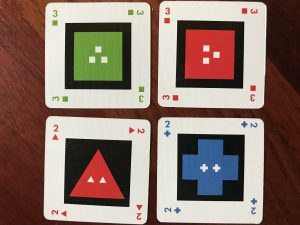
The red 2 triangle and the green 3 square were left over from the previous hand and the new cards are the blue 2 plus and the red 3 square. Player 1 decides to make the following move:
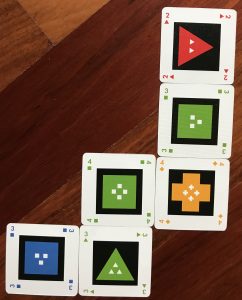
This move is worth 9 points. Player 1 is now creating a set where none of the attributes match. The final card in this set would be a blue 1 circle. Player 2 now picks two new cards and this is the new hand:
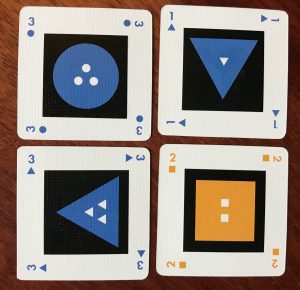
The blue 3 circle and blue 1 triangle are the new cards. Player 2 makes the following move:
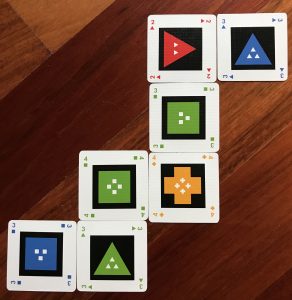
Player 2 has only added one card, the 3 blue triangle.This move is only worth 5 points. To finish this set one could add a yellow 1 triangle and a green 4 triangle or a yellow 4 triangle and a green 1 triangle.
Player 1 now picks two cards to fill the playable hand, and the hand now looks like this:
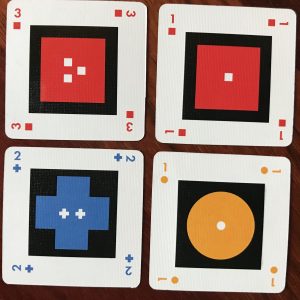
The new cards are the yellow 1 circle and the red 1 square. Player 1 decides to make the following move:
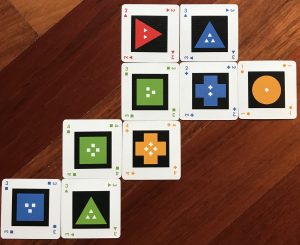
Player 1 had added the blue 2 plus and the yellow 1 circle, for a total of 11 points. Play continues in this manner until all the cards are gone. When a player completes a set of 4 the points for that turn are doubled. If a player manages to use all four cards in one turn then the points for that turn are also doubled. If a player manages to use all four cards and create a set of four in one turn, then the points are quadrupled. There are also two wildcards that can be used as any card, and they look like this:
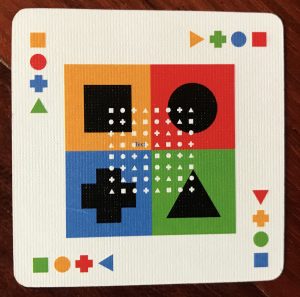
I had read so much about the card game Set and how so many people love it, and I finally tried it this summer at a games cafe. I must admit that I did not find it that exciting…maybe we played it wrong? I think that there is more strategy involved with Iota and I enjoy it much more. Next step…buying it for the classroom.
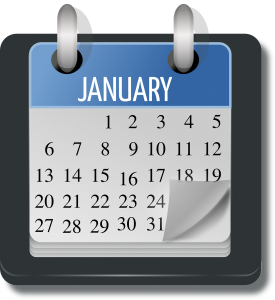 Last year I came upon (or was led to…I can’t remember) a website called Cleave Books. It is a little bit of a hodgepodge, but it has some interesting math resources. The Teacher Resources Online page brings you to a variety of template makers and information sheets. Here you will find templates for grid paper, number lines, digits of Pi, codes and ciphers, searches and cross sums, formula sheets and more, as well as practice booklets and other random activities. The Specialist Calculators Online page is basically what is says, a variety of calculators where each is devoted to a specific task. I like the Calendar Models page where you can create a yearly 3D calendar in varying forms. There is also a Pages of Puzzles section which houses generic problem solving puzzles as well as tangrams, pentominoes, dissection puzzles, and sliding block puzzles. The final area on this website that I will highlight it the MisMaths page. Here you will find math mistakes and misconceptions – could be good for same daily starters.
Last year I came upon (or was led to…I can’t remember) a website called Cleave Books. It is a little bit of a hodgepodge, but it has some interesting math resources. The Teacher Resources Online page brings you to a variety of template makers and information sheets. Here you will find templates for grid paper, number lines, digits of Pi, codes and ciphers, searches and cross sums, formula sheets and more, as well as practice booklets and other random activities. The Specialist Calculators Online page is basically what is says, a variety of calculators where each is devoted to a specific task. I like the Calendar Models page where you can create a yearly 3D calendar in varying forms. There is also a Pages of Puzzles section which houses generic problem solving puzzles as well as tangrams, pentominoes, dissection puzzles, and sliding block puzzles. The final area on this website that I will highlight it the MisMaths page. Here you will find math mistakes and misconceptions – could be good for same daily starters.

